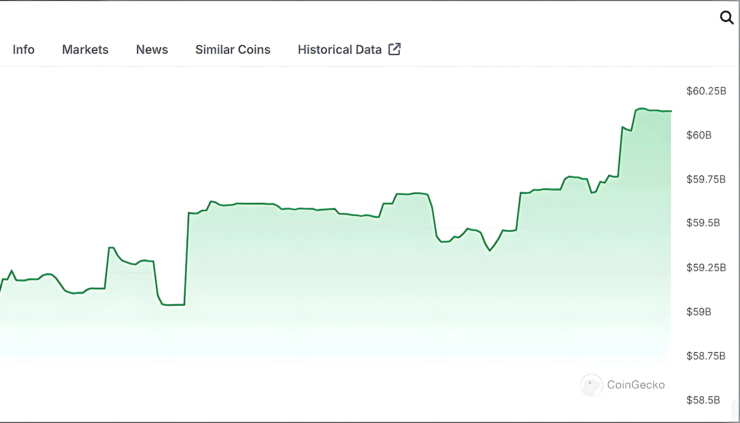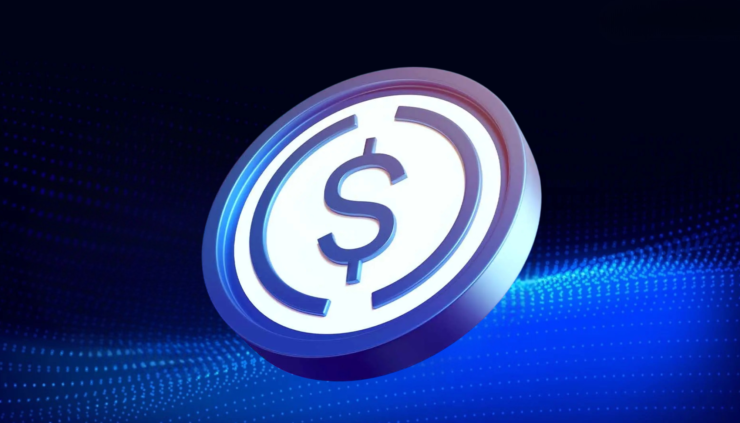The supply of USD Coin (USDC), the dollar-pegged stablecoin issued by Circle and backed by Coinbase, has officially crossed the $60 billion market cap mark; a record-setting figure that highlights its accelerating adoption and market relevance.
According to fresh data, USDC’s total supply reached 60.2 billion as of Wednesday, marking a remarkable 100% increase from March 2024, when supply sat around $30 billion. This milestone reflects growing user confidence in USDC as a secure, regulated digital dollar alternative — especially in contrast to more opaque competitors.

While USDC remains the second-largest stablecoin behind Tether’s USDT which now boasts over $144 billion in market cap , the recent growth of USDC stands out, especially as it gains traction across multiple blockchain networks.
Ethereum continues to dominate USDC’s blockchain distribution with a commanding $36 billion share of the total supply. Solana follows with $10 billion, while newer and rapidly growing chains like Base ($3.8 billion), Hyperliquid ($2.2 billion), Arbitrum ($1.8 billion), and Berachain ($1 billion) are also playing a significant role in USDC’s multi-chain expansion strategy.
This surge comes as the total market capitalization of all stablecoins combined has also reached a new peak, topping $230 billion — signaling a broader appetite for tokenized dollars and on-chain financial activity.
As stablecoins continue to shape the future of digital finance, USDC’s growing presence across ecosystems suggests it’s not just a bridge to crypto — it’s becoming an anchor in it.
Circle Expands USDC Footprint With New Chain Integrations and Japan Launch
Circle isn’t just celebrating its record-breaking $60 billion market cap — it’s also doubling down on infrastructure and international expansion to fuel even more growth.
In the first quarter of 2025, Circle aggressively ramped up USDC minting on the Solana blockchain, minting multiple batches of 250 million USDC. By March 20, total USDC supply on Solana had surged past $10 billion, making it the second-largest network for USDC after Ethereum.
Beyond Solana, Circle is pushing forward with product enhancements and global partnerships. Most notably, it officially launched USDC in Japan through a collaboration with SBI VC Trade, a landmark achievement under Japan’s newly implemented stablecoin regulations. The move positions USDC as the first foreign-issued stablecoin to operate legally in the Japanese market.
On the technical front, Circle unveiled an upgrade that will convert bridged USDC on ConsenSys’ Linea network to native USDC; a first-of-its-kind transition in the industry. This shift from bridged to native issuance signals Circle’s intent to prioritize trust, compliance, and seamless user experience across ecosystems.
In addition, Circle has begun rolling out a faster version of its Cross-Chain Transfer Protocol (CCTP), which now supports Avalanche, Base, and Ethereum. The upgrade, which slashes transfer times from minutes to seconds, will soon extend to Linea, Arbitrum, and Solana — making cross-chain USDC movement significantly more efficient.
Trump’s USD1 Stablecoin Enters the Ring
The launch of USD1, the new stablecoin from Donald Trump-backed World Liberty Financial (WLFi), adds fresh intrigue to an already heating stablecoin market; just as Circle’s USDC crosses a record-breaking $60 billion market cap.
Trump’s USD1, backed by short-term Treasuries and dollar deposits, arrives with political momentum and a bold promise to serve sovereign investors and global markets. However, its real test lies in adoption. While the stablecoin offers cross-chain compatibility and custodial security via BitGo, it enters a field where Tether’s USDT and Circe’s USDC has firmly entrenched itself as the go-to choice for regulated digital dollar transfers across multiple blockchains.
Quick Facts:
- USDC’s market capitalization has surpassed $60 billion, reaching a new all-time high.
- The circulating supply stands at over 60.18 billion USDC tokens.
- Circle’s USDC has received regulatory approval in Japan, marking it as the first regulated stablecoin in the country.
- The overall stablecoin market cap has exceeded $200 billion, indicating increased adoption and trust in stablecoins.





